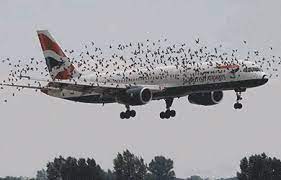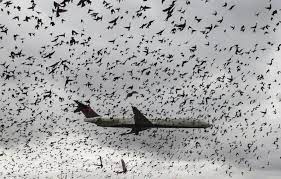Introduction
A bird strike happens when an aircraft in a flight and a bird collides or when landing or takeoff. Bird Strike is prevalent, and it can cause substantial hazards to aircraft safety. For instance, substantial damage may be caused in a small aircraft, particularly in jet-engine aircraft vulnerable to thrust loss. It causes bird ingestion in the engine air intake. This has been the cause of various fatal accidents. Since large bird numbers in a particular flight are at reduced ranks, bird strikes are more likely during the stages of takeoff, approach, landing, and initial climb. Since the majority of birds fly in the daytime, the majority of birds associated strikes happen in the daytime. Consequently, the following research aims to assess the bird species globally, the birds hearing frequencies, the species of birds’ altitude, and current technology that deters birds in airports and planes. The figures below indicate the images of birds striking.


How Many Species of Birds Exist
Birds are widely regarded as a well-studied cohort, with more than 95 percent of their global species composition approximated to have been explained. According to most scorecards used by bird watchers and scientists, there are approximately 9,000 to10, 000 birds species (Van Gasteren et al., 2019, p. 907). However, those figures are based on the “biological species concept,” which characterizes species based on what creatures can breed together. Another study conducted by Princeton University professionals found approximately 9,700 bird species globally, though this figure is debatable (Miłek and Blicharz-Domańska, 2018, p. 251). According to BirdLife.org, the world is home to nearly 11,000 different bird species (Miłek and Blicharz-Domańska, 2018, p. 251). Even though the precise number of bird species in the world varies, nearly all projections are in the 10,000-species range. So, it is safe to say that there are approximately 10,000 bird species on the planet.
What Frequencies Do Birds Hear?
Birds are a hazard to aviation and prey on a variety of crops. Even though a lethal monitor is required in many circumstances, it is normally preferable to use nonlethal methodologies to dissipate birds from specific environments for several reasons. Sound is one type of deterrent dispersal methodology (Heffner et al., 2020, p. 901). To be effective, the noises must be loud enough for birds to hear, within the frequency spectrum that the birds’ earlobes can identify, and include a biologically relevant signal that induces the birds to escape.
This makes it necessary to consider the frequency at which birds hear sounds. Hearing is number two only to vision in controlling their surroundings for birds. Avian hearing is most susceptible to sounds between 1 and 4 kHz, even if they can hear increasing and decreasing frequencies (Heffner et al., 2020, p. 902). Moreover, no bird species has demonstrated responsiveness to ultrasonic frequencies. Although responsiveness to frequencies below 20 Hz (sound) has attracted great attention, bird species have demonstrated physiological (Zeyl et al., 2020) and behavioral reactions to these low frequencies. Within the 1 – 4 kHz range, the frequency of institutional racism in birds is only around half or one-third as effective as in human beings (Zeyl et al., 2020, p. 1037). Destruction of the auditory receptors caused by loud noises is an issue that birds face as humans do.
The quantity of destruction and the intensity of the sound created varies based on the species. Birds living in airport populated places may be regularly exposed to sound thresholds that affect their hearing. Consequently, auditory alerts must be at frequency bands detectable by the damaged auditory receptors to disperse birds using sound accurately (Zeyl et al., 2020). Even though some, if not all, bird species can revolutionize hair cells, sustained exposure to loud noises would result in hearing loss.
The Species of Birds Altitude
Many bird species are located in natural environments. These environments are greater than 13,123 ft above sea level, while others regularly fly to heights of 10,000-13,000 feet which is 3,000-4,000 meters, particularly when relocating (Conkling et al., 2018). Scott wrote that a multitude of bird species navigate at even high elevations (Conkling et al., 2018). Scott is interested in how vertebrates operate in physically demanding surroundings (Conkling et al., 2018, p. 1171). Scott emphasizes that birds such as hummingbirds and sparrows exist in heights of 16,404 ft (5,000 m) in the Alpine region (Conkling et al., 2018, p. 1171). Other birds, such as massive Andean condors, are found at 18,044 feet which is 5,500 m. Mallard ducks have been observed at heights of 21,000 ft., which is 6,401 m. Moreover, the bar-headed geese in Central Asia are explicitly monitored at 23,917 ft (Conkling et al., 2018).
Such high-flyers are capable of exerting themselves at incredible heights. While the size of these birds varies, they all have one commonality: they have a larger wingspan comparative to their bodies when contrasted to birds that fly lower. However, as Scott points out, high-altitude flight necessitates more than just longer wings, which present immense physical challenges. “The first great hurdle is that the air becomes less intense” (Conkling et al., 2018, p. 1172).
They must flutter as they fly greater. Hence, they struggle to stay skyward, which increases their metabolism requirements. The availability of oxygen (O2) becomes confined and gets colder at greater heights, and birds have to warm them. Moreover, as the air becomes dry, they are more prone to losing water through respiration and water loss, leaving them thirsty. Charles Bishop asserts that physiological modifications undoubtedly permit birds to achieve extraordinary altitudes (Biteman et al., 2018). Bishop, a strong bar-headed bird’s research associate, told Reporters via email indicating that the geese birds do not struggle from heights sickness. These birds hyperventilate while piloting to continue increasing their oxygen consumption. Because of their rapid breathing, their blood becomes more basic, influencing blood flow to the brain in humans (Biteman et al., 2018, p.28). Consequently, this is why hyperventilating causes most individuals to faint or be dizzy.
However, geese are very impervious to alkaline environments or high PH states. as a result, blood flow to the creatures’ biological makeup remains normal, as the Bishop suggests. “Finally,” Bishop told Live Science, “the hemoglobin in their blood has a relatively high affinity for oxygen binding” (El-Sayed, 2019, p.109).
All through their long waves of migration, ranging from 1,243 to 3,107 miles which are 2,000 to 5,000Km, and last 5 to 200 hours, bar-headed geese use a “roller-coaster strategy” (El‐Sayed, 2019, P 108). Observations made directly of the geese’s height happened at a rate of 98% below 18,044 ft. “Whenever the geese had to fly over a high obstacle, they would immediately come down” (El-Sayed, 2019, p. 109). Furthermore, as per Scott, flying higher may give birds fair prospects for long-haul flights. Migration patterns flights at higher elevations introduce the living creatures to fewer predatory animals, while wind conditions can help the birds fly more efficiently, and cold weather can keep the living creatures from excessive heat.
Current Technology that Deters Birds in Airports and Planes
When birds are prevalent in an area of aircraft action, among the most popular techniques of scaring them off-airport land is to fire air cannons. Nevertheless airports regularly alter the neighboring surroundings to make it less bird-friendly or substituting grass with crushed rock (Biteman et al., 2018, p. 28). Some airports are compelled to get innovative to keep birds at bay. This suggests that Salt Lake City’s airport uses pigs to feed gull eggs (Arrondo et al., 2021 p. 31). Similarly, border collies chase away egrets and herons at Southwest Florida International.
Conclusion
A bird strike occurs when an aircraft in flight collides with a bird or when landing or taking off. Bird strikes are common, posing significant risks to aircraft safety. Because of most birds in flight at subordinates, bird strikes seem to be more probable during the departure airport, preliminary climb, attitude, and arrival stages. Birds are widely regarded as a well-studied group, with more than 95 percent of their global species composition roughly explained. Birds threaten aviation and prey on a wide range of crops. Although lethal control is required in many situations, it is frequently preferable to use nonlethal methods to disperse or deter birds from specific locations for various reasons.
Most of these species live in natural environments that are more than 13,123 ft (4,000 meters) above sea level. Others normally tend to fly heights 10,000-13,000 ft when relocating (Miłek and Blicharz-Domańska, 2018, p. 252). When birds are abundant in an area of aircraft activity, one of the most common methods of scaring them off-airport land is to fire air cannons, but airports also frequently alter the surrounding environment to make it less bird-friendly, such as filling in ponds or replacing grass with crushed rock. In the appearance of bird exercise, postpone takeoff or touching down. The plane should keep the speed below 10,000 feet to less than 250 tangles if feasible (Biteman et al., 2018, 29). Afterward, they should ascend at the fastest possible rate below 2,000 feet to reduce flight time vulnerability to a potential attack danger.
List of References
Arrondo, E., García-Alfonso, M., Blas, J., Cortes-Avizanda, A., De la Riva, M., Devault, T., Fiedler, W., Flack, A., Jimenez, J., Lambertucci, S., Margalida, A., Oliva-Vidal, P., Phipps, L., Sanchez-Zapata, J., Wikelski, M. and Donazar, J. 2021). Use of avian GPS tracking to mitigate human fatalities from bird strikes caused by large soaring birds. Journal of Applied Ecology. Volume 2, pp.31-34
Biteman, D., Collins, D. and Washburn, B., 2018. Sunshine, Beaches, and Birds: Managing Raptor-Aircraft collisions at airports in Southern California. Proceedings of the Vertebrate Pest Conference, 28. pp. 28-35.
Conkling, T., Belant, J., DeVault, T. and Martin, J., 2018. Impacts of biomass production at civil airports on grassland bird conservation and aviation strike risk. Ecological Applications, 28(5), pp. 1168-1181.
El-Sayed, A., 2022. Bird Strike in Aviation. Zagazig University Press. 25(3), 98-111.
Heffner, R., Cumming, J., Koay, G. and Heffner, H., 2020. Hearing in Indian peafowl (Pavo cristatus): sensitivity to infrasound. Journal of Comparative Physiology A, 206(6), pp. 899-906.
Miłek, J. and Blicharz-Domańska, K., 2018. Coronaviruses in avian species – review with focus on epidemiology and diagnosis in wild birds. Journal of Veterinary Research, 62(3), pp. 249-255.
Van Gasteren, H., Krijgsveld, K., Klauke, N., Leshem, Y., Metz, I., Skakuj, M., Sorbi, S., Schekler, I. and Shamoun‐Baranes, J., 2019. Aeroecology meets aviation safety: early warning systems in Europe and the Middle East prevent collisions between birds and aircraft. Ecography, 42(5), pp. 899-911.
Zeyl, J., Ouden, O., Köppl, C., Assink, J., Christensen-Dalsgaard, J., Patrick, S. and Clusella‐Trullas, S., 2020. Infrasonic hearing in birds: a review of audiometry and hypothesized structure–function relationships. Biological Reviews, 95(4), pp. 1036-1054.